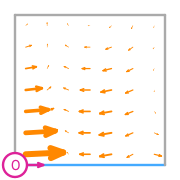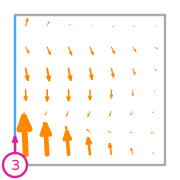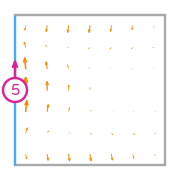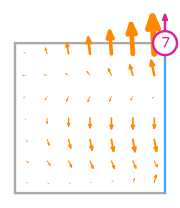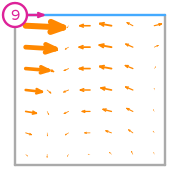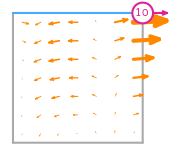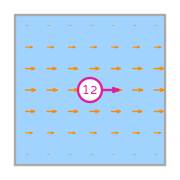an encyclopedia of finite element definitions
Degree 2 serendipity H(curl) on a quadrilateral
◀ Back to serendipity H(curl) definition page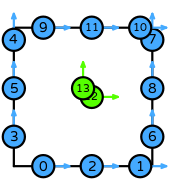
- \(R\) is the reference quadrilateral. The following numbering of the subentities of the reference is used:
- \(\mathcal{V}\) is spanned by: \(\left(\begin{array}{c}\displaystyle 1\\\displaystyle 0\end{array}\right)\), \(\left(\begin{array}{c}\displaystyle 0\\\displaystyle 1\end{array}\right)\), \(\left(\begin{array}{c}\displaystyle x\\\displaystyle 0\end{array}\right)\), \(\left(\begin{array}{c}\displaystyle 0\\\displaystyle x\end{array}\right)\), \(\left(\begin{array}{c}\displaystyle x^{2}\\\displaystyle 0\end{array}\right)\), \(\left(\begin{array}{c}\displaystyle 0\\\displaystyle x^{2}\end{array}\right)\), \(\left(\begin{array}{c}\displaystyle y\\\displaystyle 0\end{array}\right)\), \(\left(\begin{array}{c}\displaystyle 0\\\displaystyle y\end{array}\right)\), \(\left(\begin{array}{c}\displaystyle x y\\\displaystyle 0\end{array}\right)\), \(\left(\begin{array}{c}\displaystyle 0\\\displaystyle x y\end{array}\right)\), \(\left(\begin{array}{c}\displaystyle y^{2}\\\displaystyle 0\end{array}\right)\), \(\left(\begin{array}{c}\displaystyle 0\\\displaystyle y^{2}\end{array}\right)\), \(\left(\begin{array}{c}\displaystyle 3 x^{2} y\\\displaystyle - x^{3}\end{array}\right)\), \(\left(\begin{array}{c}\displaystyle y^{3}\\\displaystyle 3 x y^{2}\end{array}\right)\)
- \(\mathcal{L}=\{l_0,...,l_{13}\}\)
- Functionals and basis functions:

\(\displaystyle l_{0}:\boldsymbol{v}\mapsto\displaystyle\int_{e_{0}}\boldsymbol{v}\cdot(2 s_{0}^{2} - 3 s_{0} + 1)\hat{\boldsymbol{t}}_{0}\)
where \(e_{0}\) is the 0th edge;
\(\hat{\boldsymbol{t}}_{0}\) is the tangent to edge 0;
and \(s_{0},s_{1}\) is a parametrisation of \(e_{0}\).
\(\displaystyle \boldsymbol{\phi}_{0} = \left(\begin{array}{c}\displaystyle - 30 x^{2} y + 30 x^{2} + 36 x y - 36 x + 3 y^{2} - 12 y + 9\\\displaystyle 5 x \left(2 x^{2} - 3 x + 1\right)\end{array}\right)\)
This DOF is associated with edge 0 of the reference element.
where \(e_{0}\) is the 0th edge;
\(\hat{\boldsymbol{t}}_{0}\) is the tangent to edge 0;
and \(s_{0},s_{1}\) is a parametrisation of \(e_{0}\).
\(\displaystyle \boldsymbol{\phi}_{0} = \left(\begin{array}{c}\displaystyle - 30 x^{2} y + 30 x^{2} + 36 x y - 36 x + 3 y^{2} - 12 y + 9\\\displaystyle 5 x \left(2 x^{2} - 3 x + 1\right)\end{array}\right)\)
This DOF is associated with edge 0 of the reference element.
\(\displaystyle l_{1}:\boldsymbol{v}\mapsto\displaystyle\int_{e_{0}}\boldsymbol{v}\cdot(s_{0} \left(2 s_{0} - 1\right))\hat{\boldsymbol{t}}_{0}\)
where \(e_{0}\) is the 0th edge;
\(\hat{\boldsymbol{t}}_{0}\) is the tangent to edge 0;
and \(s_{0},s_{1}\) is a parametrisation of \(e_{0}\).
\(\displaystyle \boldsymbol{\phi}_{1} = \left(\begin{array}{c}\displaystyle - 30 x^{2} y + 30 x^{2} + 24 x y - 24 x + 3 y^{2} - 6 y + 3\\\displaystyle 5 x \left(2 x^{2} - 3 x + 1\right)\end{array}\right)\)
This DOF is associated with edge 0 of the reference element.
where \(e_{0}\) is the 0th edge;
\(\hat{\boldsymbol{t}}_{0}\) is the tangent to edge 0;
and \(s_{0},s_{1}\) is a parametrisation of \(e_{0}\).
\(\displaystyle \boldsymbol{\phi}_{1} = \left(\begin{array}{c}\displaystyle - 30 x^{2} y + 30 x^{2} + 24 x y - 24 x + 3 y^{2} - 6 y + 3\\\displaystyle 5 x \left(2 x^{2} - 3 x + 1\right)\end{array}\right)\)
This DOF is associated with edge 0 of the reference element.
\(\displaystyle l_{2}:\boldsymbol{v}\mapsto\displaystyle\int_{e_{0}}\boldsymbol{v}\cdot(4 s_{0} \left(1 - s_{0}\right))\hat{\boldsymbol{t}}_{0}\)
where \(e_{0}\) is the 0th edge;
\(\hat{\boldsymbol{t}}_{0}\) is the tangent to edge 0;
and \(s_{0},s_{1}\) is a parametrisation of \(e_{0}\).
\(\displaystyle \boldsymbol{\phi}_{2} = \left(\begin{array}{c}\displaystyle 15 x^{2} y - 15 x^{2} - 15 x y + 15 x + 3 y^{2} - \frac{3 y}{2} - \frac{3}{2}\\\displaystyle \frac{5 x \left(- 2 x^{2} + 3 x - 1\right)}{2}\end{array}\right)\)
This DOF is associated with edge 0 of the reference element.
where \(e_{0}\) is the 0th edge;
\(\hat{\boldsymbol{t}}_{0}\) is the tangent to edge 0;
and \(s_{0},s_{1}\) is a parametrisation of \(e_{0}\).
\(\displaystyle \boldsymbol{\phi}_{2} = \left(\begin{array}{c}\displaystyle 15 x^{2} y - 15 x^{2} - 15 x y + 15 x + 3 y^{2} - \frac{3 y}{2} - \frac{3}{2}\\\displaystyle \frac{5 x \left(- 2 x^{2} + 3 x - 1\right)}{2}\end{array}\right)\)
This DOF is associated with edge 0 of the reference element.
\(\displaystyle l_{3}:\boldsymbol{v}\mapsto\displaystyle\int_{e_{1}}\boldsymbol{v}\cdot(2 s_{0}^{2} - 3 s_{0} + 1)\hat{\boldsymbol{t}}_{1}\)
where \(e_{1}\) is the 1st edge;
\(\hat{\boldsymbol{t}}_{1}\) is the tangent to edge 1;
and \(s_{0},s_{1}\) is a parametrisation of \(e_{1}\).
\(\displaystyle \boldsymbol{\phi}_{3} = \left(\begin{array}{c}\displaystyle 5 y \left(- 2 y^{2} + 3 y - 1\right)\\\displaystyle 3 x^{2} - 30 x y^{2} + 36 x y - 12 x + 30 y^{2} - 36 y + 9\end{array}\right)\)
This DOF is associated with edge 1 of the reference element.
where \(e_{1}\) is the 1st edge;
\(\hat{\boldsymbol{t}}_{1}\) is the tangent to edge 1;
and \(s_{0},s_{1}\) is a parametrisation of \(e_{1}\).
\(\displaystyle \boldsymbol{\phi}_{3} = \left(\begin{array}{c}\displaystyle 5 y \left(- 2 y^{2} + 3 y - 1\right)\\\displaystyle 3 x^{2} - 30 x y^{2} + 36 x y - 12 x + 30 y^{2} - 36 y + 9\end{array}\right)\)
This DOF is associated with edge 1 of the reference element.
\(\displaystyle l_{4}:\boldsymbol{v}\mapsto\displaystyle\int_{e_{1}}\boldsymbol{v}\cdot(s_{0} \left(2 s_{0} - 1\right))\hat{\boldsymbol{t}}_{1}\)
where \(e_{1}\) is the 1st edge;
\(\hat{\boldsymbol{t}}_{1}\) is the tangent to edge 1;
and \(s_{0},s_{1}\) is a parametrisation of \(e_{1}\).
\(\displaystyle \boldsymbol{\phi}_{4} = \left(\begin{array}{c}\displaystyle 5 y \left(- 2 y^{2} + 3 y - 1\right)\\\displaystyle 3 x^{2} - 30 x y^{2} + 24 x y - 6 x + 30 y^{2} - 24 y + 3\end{array}\right)\)
This DOF is associated with edge 1 of the reference element.
where \(e_{1}\) is the 1st edge;
\(\hat{\boldsymbol{t}}_{1}\) is the tangent to edge 1;
and \(s_{0},s_{1}\) is a parametrisation of \(e_{1}\).
\(\displaystyle \boldsymbol{\phi}_{4} = \left(\begin{array}{c}\displaystyle 5 y \left(- 2 y^{2} + 3 y - 1\right)\\\displaystyle 3 x^{2} - 30 x y^{2} + 24 x y - 6 x + 30 y^{2} - 24 y + 3\end{array}\right)\)
This DOF is associated with edge 1 of the reference element.
\(\displaystyle l_{5}:\boldsymbol{v}\mapsto\displaystyle\int_{e_{1}}\boldsymbol{v}\cdot(4 s_{0} \left(1 - s_{0}\right))\hat{\boldsymbol{t}}_{1}\)
where \(e_{1}\) is the 1st edge;
\(\hat{\boldsymbol{t}}_{1}\) is the tangent to edge 1;
and \(s_{0},s_{1}\) is a parametrisation of \(e_{1}\).
\(\displaystyle \boldsymbol{\phi}_{5} = \left(\begin{array}{c}\displaystyle \frac{5 y \left(2 y^{2} - 3 y + 1\right)}{2}\\\displaystyle 3 x^{2} + 15 x y^{2} - 15 x y - \frac{3 x}{2} - 15 y^{2} + 15 y - \frac{3}{2}\end{array}\right)\)
This DOF is associated with edge 1 of the reference element.
where \(e_{1}\) is the 1st edge;
\(\hat{\boldsymbol{t}}_{1}\) is the tangent to edge 1;
and \(s_{0},s_{1}\) is a parametrisation of \(e_{1}\).
\(\displaystyle \boldsymbol{\phi}_{5} = \left(\begin{array}{c}\displaystyle \frac{5 y \left(2 y^{2} - 3 y + 1\right)}{2}\\\displaystyle 3 x^{2} + 15 x y^{2} - 15 x y - \frac{3 x}{2} - 15 y^{2} + 15 y - \frac{3}{2}\end{array}\right)\)
This DOF is associated with edge 1 of the reference element.
\(\displaystyle l_{6}:\boldsymbol{v}\mapsto\displaystyle\int_{e_{2}}\boldsymbol{v}\cdot(2 s_{0}^{2} - 3 s_{0} + 1)\hat{\boldsymbol{t}}_{2}\)
where \(e_{2}\) is the 2nd edge;
\(\hat{\boldsymbol{t}}_{2}\) is the tangent to edge 2;
and \(s_{0},s_{1}\) is a parametrisation of \(e_{2}\).
\(\displaystyle \boldsymbol{\phi}_{6} = \left(\begin{array}{c}\displaystyle 5 y \left(2 y^{2} - 3 y + 1\right)\\\displaystyle 3 x \left(x + 10 y^{2} - 12 y + 2\right)\end{array}\right)\)
This DOF is associated with edge 2 of the reference element.
where \(e_{2}\) is the 2nd edge;
\(\hat{\boldsymbol{t}}_{2}\) is the tangent to edge 2;
and \(s_{0},s_{1}\) is a parametrisation of \(e_{2}\).
\(\displaystyle \boldsymbol{\phi}_{6} = \left(\begin{array}{c}\displaystyle 5 y \left(2 y^{2} - 3 y + 1\right)\\\displaystyle 3 x \left(x + 10 y^{2} - 12 y + 2\right)\end{array}\right)\)
This DOF is associated with edge 2 of the reference element.
\(\displaystyle l_{7}:\boldsymbol{v}\mapsto\displaystyle\int_{e_{2}}\boldsymbol{v}\cdot(s_{0} \left(2 s_{0} - 1\right))\hat{\boldsymbol{t}}_{2}\)
where \(e_{2}\) is the 2nd edge;
\(\hat{\boldsymbol{t}}_{2}\) is the tangent to edge 2;
and \(s_{0},s_{1}\) is a parametrisation of \(e_{2}\).
\(\displaystyle \boldsymbol{\phi}_{7} = \left(\begin{array}{c}\displaystyle 5 y \left(2 y^{2} - 3 y + 1\right)\\\displaystyle 3 x \left(x + 10 y^{2} - 8 y\right)\end{array}\right)\)
This DOF is associated with edge 2 of the reference element.
where \(e_{2}\) is the 2nd edge;
\(\hat{\boldsymbol{t}}_{2}\) is the tangent to edge 2;
and \(s_{0},s_{1}\) is a parametrisation of \(e_{2}\).
\(\displaystyle \boldsymbol{\phi}_{7} = \left(\begin{array}{c}\displaystyle 5 y \left(2 y^{2} - 3 y + 1\right)\\\displaystyle 3 x \left(x + 10 y^{2} - 8 y\right)\end{array}\right)\)
This DOF is associated with edge 2 of the reference element.
\(\displaystyle l_{8}:\boldsymbol{v}\mapsto\displaystyle\int_{e_{2}}\boldsymbol{v}\cdot(4 s_{0} \left(1 - s_{0}\right))\hat{\boldsymbol{t}}_{2}\)
where \(e_{2}\) is the 2nd edge;
\(\hat{\boldsymbol{t}}_{2}\) is the tangent to edge 2;
and \(s_{0},s_{1}\) is a parametrisation of \(e_{2}\).
\(\displaystyle \boldsymbol{\phi}_{8} = \left(\begin{array}{c}\displaystyle \frac{5 y \left(- 2 y^{2} + 3 y - 1\right)}{2}\\\displaystyle \frac{3 x \left(2 x - 10 y^{2} + 10 y - 3\right)}{2}\end{array}\right)\)
This DOF is associated with edge 2 of the reference element.
where \(e_{2}\) is the 2nd edge;
\(\hat{\boldsymbol{t}}_{2}\) is the tangent to edge 2;
and \(s_{0},s_{1}\) is a parametrisation of \(e_{2}\).
\(\displaystyle \boldsymbol{\phi}_{8} = \left(\begin{array}{c}\displaystyle \frac{5 y \left(- 2 y^{2} + 3 y - 1\right)}{2}\\\displaystyle \frac{3 x \left(2 x - 10 y^{2} + 10 y - 3\right)}{2}\end{array}\right)\)
This DOF is associated with edge 2 of the reference element.
\(\displaystyle l_{9}:\boldsymbol{v}\mapsto\displaystyle\int_{e_{3}}\boldsymbol{v}\cdot(2 s_{0}^{2} - 3 s_{0} + 1)\hat{\boldsymbol{t}}_{3}\)
where \(e_{3}\) is the 3rd edge;
\(\hat{\boldsymbol{t}}_{3}\) is the tangent to edge 3;
and \(s_{0},s_{1}\) is a parametrisation of \(e_{3}\).
\(\displaystyle \boldsymbol{\phi}_{9} = \left(\begin{array}{c}\displaystyle 3 y \left(10 x^{2} - 12 x + y + 2\right)\\\displaystyle 5 x \left(- 2 x^{2} + 3 x - 1\right)\end{array}\right)\)
This DOF is associated with edge 3 of the reference element.
where \(e_{3}\) is the 3rd edge;
\(\hat{\boldsymbol{t}}_{3}\) is the tangent to edge 3;
and \(s_{0},s_{1}\) is a parametrisation of \(e_{3}\).
\(\displaystyle \boldsymbol{\phi}_{9} = \left(\begin{array}{c}\displaystyle 3 y \left(10 x^{2} - 12 x + y + 2\right)\\\displaystyle 5 x \left(- 2 x^{2} + 3 x - 1\right)\end{array}\right)\)
This DOF is associated with edge 3 of the reference element.
\(\displaystyle l_{10}:\boldsymbol{v}\mapsto\displaystyle\int_{e_{3}}\boldsymbol{v}\cdot(s_{0} \left(2 s_{0} - 1\right))\hat{\boldsymbol{t}}_{3}\)
where \(e_{3}\) is the 3rd edge;
\(\hat{\boldsymbol{t}}_{3}\) is the tangent to edge 3;
and \(s_{0},s_{1}\) is a parametrisation of \(e_{3}\).
\(\displaystyle \boldsymbol{\phi}_{10} = \left(\begin{array}{c}\displaystyle 3 y \left(10 x^{2} - 8 x + y\right)\\\displaystyle 5 x \left(- 2 x^{2} + 3 x - 1\right)\end{array}\right)\)
This DOF is associated with edge 3 of the reference element.
where \(e_{3}\) is the 3rd edge;
\(\hat{\boldsymbol{t}}_{3}\) is the tangent to edge 3;
and \(s_{0},s_{1}\) is a parametrisation of \(e_{3}\).
\(\displaystyle \boldsymbol{\phi}_{10} = \left(\begin{array}{c}\displaystyle 3 y \left(10 x^{2} - 8 x + y\right)\\\displaystyle 5 x \left(- 2 x^{2} + 3 x - 1\right)\end{array}\right)\)
This DOF is associated with edge 3 of the reference element.
\(\displaystyle l_{11}:\boldsymbol{v}\mapsto\displaystyle\int_{e_{3}}\boldsymbol{v}\cdot(4 s_{0} \left(1 - s_{0}\right))\hat{\boldsymbol{t}}_{3}\)
where \(e_{3}\) is the 3rd edge;
\(\hat{\boldsymbol{t}}_{3}\) is the tangent to edge 3;
and \(s_{0},s_{1}\) is a parametrisation of \(e_{3}\).
\(\displaystyle \boldsymbol{\phi}_{11} = \left(\begin{array}{c}\displaystyle \frac{3 y \left(- 10 x^{2} + 10 x + 2 y - 3\right)}{2}\\\displaystyle \frac{5 x \left(2 x^{2} - 3 x + 1\right)}{2}\end{array}\right)\)
This DOF is associated with edge 3 of the reference element.
where \(e_{3}\) is the 3rd edge;
\(\hat{\boldsymbol{t}}_{3}\) is the tangent to edge 3;
and \(s_{0},s_{1}\) is a parametrisation of \(e_{3}\).
\(\displaystyle \boldsymbol{\phi}_{11} = \left(\begin{array}{c}\displaystyle \frac{3 y \left(- 10 x^{2} + 10 x + 2 y - 3\right)}{2}\\\displaystyle \frac{5 x \left(2 x^{2} - 3 x + 1\right)}{2}\end{array}\right)\)
This DOF is associated with edge 3 of the reference element.
\(\displaystyle l_{12}:\boldsymbol{v}\mapsto\displaystyle\int_{R}\boldsymbol{v}\cdot\left(\begin{array}{c}1\\0\end{array}\right)\)
where \(R\) is the reference element.
\(\displaystyle \boldsymbol{\phi}_{12} = \left(\begin{array}{c}\displaystyle 6 y \left(1 - y\right)\\\displaystyle 0\end{array}\right)\)
This DOF is associated with face 0 of the reference element.
where \(R\) is the reference element.
\(\displaystyle \boldsymbol{\phi}_{12} = \left(\begin{array}{c}\displaystyle 6 y \left(1 - y\right)\\\displaystyle 0\end{array}\right)\)
This DOF is associated with face 0 of the reference element.
\(\displaystyle l_{13}:\boldsymbol{v}\mapsto\displaystyle\int_{R}\boldsymbol{v}\cdot\left(\begin{array}{c}0\\1\end{array}\right)\)
where \(R\) is the reference element.
\(\displaystyle \boldsymbol{\phi}_{13} = \left(\begin{array}{c}\displaystyle 0\\\displaystyle 6 x \left(1 - x\right)\end{array}\right)\)
This DOF is associated with face 0 of the reference element.
where \(R\) is the reference element.
\(\displaystyle \boldsymbol{\phi}_{13} = \left(\begin{array}{c}\displaystyle 0\\\displaystyle 6 x \left(1 - x\right)\end{array}\right)\)
This DOF is associated with face 0 of the reference element.
